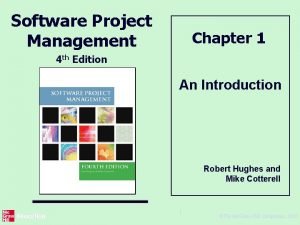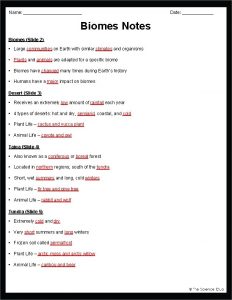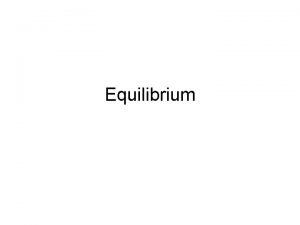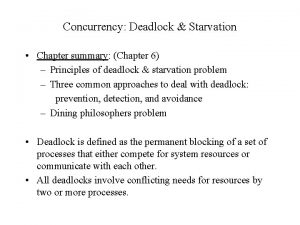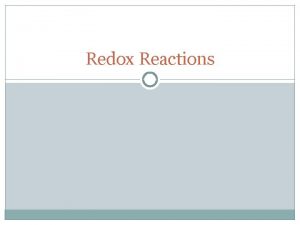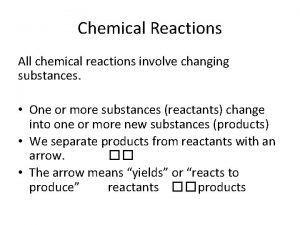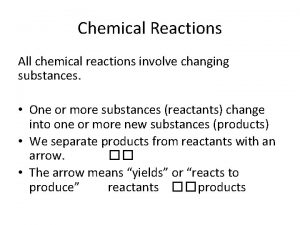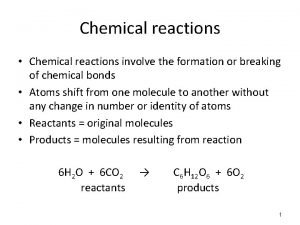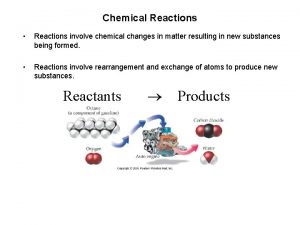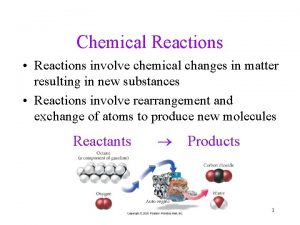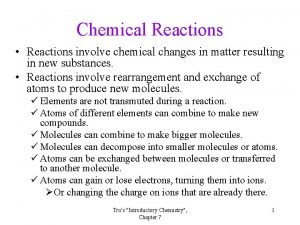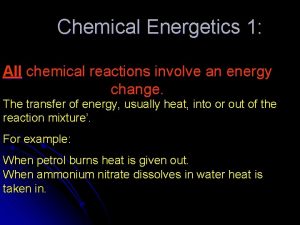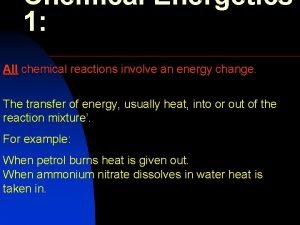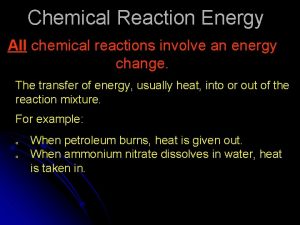Categorizing Chemical Reactions l All chemical reactions involve












- Slides: 12

Categorizing Chemical Reactions l All chemical reactions involve something moving, so we can categorize the types of reactions we just learned to help us predict the products in a reaction! l Moving electrons = synthesis, decomposition, and single displacement l Moving ions = double displacement l Moving protons = acid/base reaction (we’ll get into this in a later unit) l Combustion is actually a combination of these

Moving Electrons In these reactions, one or more electrons move from one atom to another, allowing those atoms to act differently than in their original compounds. l Ex: l l Mg + Br 2 Mg. Br 2 l Na. Cl Na + Cl 2 l Zn + Cu. SO 4 Cu + Zn. SO 4

l This first example should make sense because this is simply the creation of an ionic bond, from the transfer of electrons: l Mg + Br 2 Mg. Br 2

l The second example is just the opposite, breaking down an ionic bond. l 2 Na. Cl 2 Na + Cl 2

l Ex: Zn + Cu. SO 4 Cu + Zn. SO 4 Remember Cu. SO 4 is an ionic compound, so it really is made of Cu+2 and SO 4 -2, while Zn is starting off neutral in the reactants l During this reaction, Zn transfers its electrons to Cu+2, turning the metals into a Zn+2 ion and a neutral Cu atom. l Now that Zn+2 has a charge, it will form the ionic compound with SO 4 -2 because of opposite charges. l

In this case, did the sulfate ion see an change of electrons? l No, so these electrons were not involved in the reaction and weren’t shown, but remember sulfate has 2 extra electrons to make its structure stable (the -2 charge) l

Reduction and Oxidation l In these reactions, one atom or element is reduced and the other is oxidized l So you’ll often hear these called Redox reactions l A substance that is reduced has gained electrons l and l therefore reduced its charge A substance that is oxidized has lost electrons

2 Fun Ways to Remember l l l OIL RIG Oxidation Is Losing elections Reduction Is Gaining electrons l l l LEOGER or LEO the lion says GER Losing Electrons is Oxidation, Gaining Electrons is Reduction

And now, the tricky part… A substance that has been oxidized is called a reducing AGENT because it caused the other substance to take their electrons l A substance that has been reduced is called an oxidizing AGENT because it caused the other substance to give up its own electrons l

l Br starts with 0 charge and ends with -1 l l Mg starts with 0 charge and ends with +2 l l l The charge has gone down, because Br has gained electrons. The charge has gone up, because Mg has lost electrons. This means Br has been ______ and is the _______ agent. reduced oxidizing This means Mg has been ______ and is the _______ agent. oxidized reducing

l Na starts with a +1 charge, ends with 0 charge l Cl starts with a -1 charge, ends with 0 charge l Charge l l has gone down because it gained electrons has gone up because it lost electrons This means Na has been _______ and is the ______ agent. reduced oxidizing This means Cl has been ______ and is the _______ agent. oxidized reducing

l Zn started with 0 charge, ended with +2 l l Charge has gone up because it lost electrons Cu started with +2 charge, ended with 0 l Charge has gone down because it gained electrons l SO 4 started and ended with -2, no electrons changed here l Zn has been oxidized and is the reducing agent Cu has been reduced and is the oxidizing agent SO 4 wasn’t really involved in this reaction then… l l
 Chemical reactions section 2 classifying chemical reactions
Chemical reactions section 2 classifying chemical reactions Section 2 classifying chemical reactions
Section 2 classifying chemical reactions Types of reactions
Types of reactions Categorizing different types of memory
Categorizing different types of memory Objective-based categorizing projects is possible
Objective-based categorizing projects is possible Categorizing materials
Categorizing materials Categorizing equations
Categorizing equations Land biomes lesson outline answers
Land biomes lesson outline answers Equilibrium
Equilibrium Chemical reactions section 1 chemical changes
Chemical reactions section 1 chemical changes Are kc and kp equal
Are kc and kp equal Integrated deadlock strategy
Integrated deadlock strategy Opposite rays
Opposite rays




